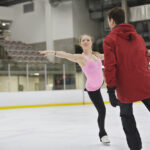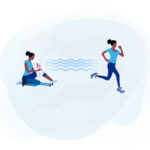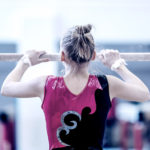Relative energy deficiency in sport (REDs): When athletes run on empty

The strength, skill, and speed of Olympic athletes help the rest of us understand human potential in a new light.
But athletic glory can come at a high price. The quest to be the best can drive some athletes into punishing training routines, denying themselves of food and other basic needs. Whether training for the Olympics or for a local tournament, when athletes don’t “refuel” sufficiently between workouts, the energy imbalance can deplete both their athletic performance and overall health. In 2014, the International Olympic Committee recognized this cycle as relative energy deficiency in sport (REDs).
Relative energy deficiency in sport (REDs) describes a syndrome of poor health and declining athletic performance that happens when athletes do not get enough fuel through food to support the energy demands of their daily lives and training. REDs affects athletes of any gender and ability level.
Energy deficiency can creep up on athletes. They may believe that restricting their eating is necessary to reach the pinnacle of their sport when in fact, it does the opposite, says Dr. Miriam Rowan, a psychologist with Boston Children’s Sports Medicine Division and Female Athlete Program. “In the end, the things an athlete is trying to achieve often slip out of reach as their body becomes more depleted of energy.”
Here, we talk with Dr. Rowan about REDs, what puts athletes at risk, and what it takes to change eating behaviors.
Is there a relationship between REDs and eating disorders?
Even though they often overlap, REDs and eating disorders are not the same thing. One common symptom of both REDs and some eating disorders is a state of low energy availability. In this state, athletes may feel constantly tired, have trouble concentrating, and see their athletic performance decline. But while having an eating disorder increases an athlete’s risk for developing REDs, athletes with REDs do not necessarily have eating disorders.
While having an eating disorder increases an athlete’s risk of REDs, an athlete with REDs does not necessarily have an eating disorder.”
Dr. Miriam Rowan
With REDs, an athlete may not realize they aren’t eating enough to compensate for their energy expenditure. An athlete could also consciously be limiting their food intake, perhaps due to a misunderstanding of the energy they need to perform optimally in their sport. Often, basic education about REDs can motivate athletes to start fueling adequately.
With an eating disorder, under-fueling is more often driven by distorted thoughts, unregulated emotions, difficulties in one’s relationship to food, or a compulsive drive for thinness. Other very concerning symptoms, for instance, fluid imbalances, dental problems, and esophageal tears in the case of bulimia nervosa, may emerge as well.
What are some other reasons athletes don’t refuel properly?
Many athletic activities were suspended due to the pandemic. As athletes return to their previous level of training, they may not realize how quickly and greatly their energy needs increase.
For other athletes, it’s a matter of budget. Some may simply not have the financial resources to keep up with the energy demands of their training.
Do certain sports carry a higher risk of REDs?
The risk is higher for athletes who participate in endurance sports such as running, cross-country skiing, and cycling. There’s a high incidence of REDs in aesthetic sports, such as ballet and figure skating. Athletes in weight-class sports like wrestling and lightweight rowing, where they have to weigh in before they can compete, are also at greater risk.
How does sports culture contribute to REDs?
Certain mindsets, such as an overemphasis on leanness, increase athletes’ risk. In recent years, elite athletes like marathon runner Mary Cain and cross-country skier Hannah Halvorsen have spoken out about the pressure on female athletes to lose weight or maintain a certain body type. I think they are important role models for young athletes.
There’s a culture of risk in many sports that glorifies athletes who dangerously endure pain under any circumstances.”
Dr. Miriam Rowan
There’s also a culture of risk in many sports that glorifies athletes who dangerously endure pain under any circumstances. Unfortunately, this extreme version of “no pain, no gain” can lead to the inaccurate belief that ignoring physical hunger is a sign of strength.
When do athletes typically seek treatment for REDs?
Many of the athletes we treat at Boston Children’s come to us when chronic energy deficiency has weakened their bones and they experience symptoms such as repeat fractures. Other athletes we see are young women who have stopped menstruating, or never started.
Unfortunately, there’s less public awareness around energy deficiency in male athletes. Because of this, male athletes often wait longer before they seek treatment. We need to provide more education on REDs specifically for these athletes.
What might prevent an athlete with REDs from changing the way they eat?
Athletes are masters at self-control — that’s part of what makes them so good at their sports. Giving up that control can be very frightening. They may believe if they change the way they eat, they’ll lose their edge.
They may also feel pressure from their peers or coach to continue restricting their diet. Suddenly we’re telling them they need to eat more, and they’re not sure who to trust. It can be very confusing.
What makes athletes decide to adopt more healthy eating habits?
One of the things we do in the Female Athlete Program is help athletes take a step back and think about their values. Why did they choose to pursue this activity and what are their long-term goals? By thinking about their futures and realizing they want to remain active in their 30s and 40s, many athletes gain new perspective on what they’re doing in the present.
Also, simple education on REDs symptoms and long-term consequences can convince many athletes that proper fueling is essential.
What early signs of REDs should parents, athletes, and coaches be on the lookout for?
If an athlete is constantly tired, if their performance is suffering no matter how hard they train, if they are less coordinated and less able to focus, they could be in a state of energy deficiency. Increased frequency of head colds and illness are other signs, as well as psychological changes like low mood, irritability, or anxiety. Bone stress injuries or, in female athletes, an irregular menstrual cycle are other common signs. If an athlete has any of these symptoms, they should seek an assessment from a sports medicine professional with experience treating REDs.
If you think you or your child is at risk of REDs, contact Boston Children’s Female Athlete Program or Sports Medicine Division.
Related Posts :
-

Fancy footwork: Two figure skating experts on injury prevention
Amazing costumes, breathtaking artistry, and outstanding athleticism. No wonder figure skating is a Winter Olympics must-watch for millions of people. ...
-

Not just a physical thing: The psychology of sports injuries and recovery
“Nobody plays sports expecting to get injured, but unfortunately, injuries are part of sports,” says Melissa Christino, MD. As a ...
-

Athletes and fatigue: Why am I so tired?
Working out can boost physical and mental energy. Yet sometimes, athletes feel more fatigued than energized. "Feeling tired after a ...
-

Study links urinary incontinence in female athletes to low energy availability
Urinary incontinence (UI) is a common experience for female athletes that can significantly impact their enjoyment of and participation in ...





